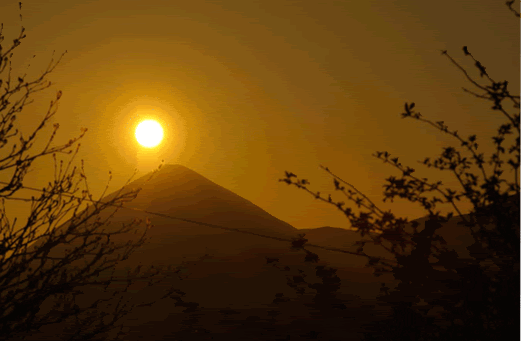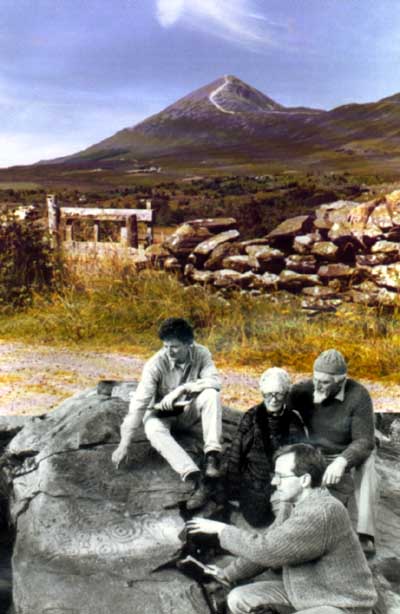The 'Rolling Sun' Spectacle of Boheh
by Gerry Bracken.
To the casual observer, St. Patrick's Chair, Boheh, is not particularly impressive. A large fractured rock, jutting out of the ground at the end of a row of cattle sheds, with a rich covering of weeds and briars; it probably escaped demolition solely because of a long-forgotten association with our National Saint.

I first saw it in 1981, when making a list of antiquities in the Westport area. There is indeed a rough 'chair' on one side, but what caught my attention in the glancing sunlight that evening was the many concentric circles etched into the sloping faces of the outcrop, and all over the flat top. Faded from weathering, I realised this rock art pre-dated St. Patrick's arrival in the West of Ireland by at least two thousand years.
Although now surrounded by high hedges, the Boheh Rock originally commanded an unrestricted view to the west, dominated by the striking pyramid-mountain of Croagh Patrick.
Intrigued by this enigma, I began a study of 'Cup and Ring' motifs in an effort to understand why this rock was selected for such elaborate treatment. I learned that while this art form is also found in the north-west and south-west of Ireland, St. Patrick's Chair is the sole example known west of the Shannon. It is also the most comprehensively worked example in Ireland.

All the experts date this type of rock art to the late Stone Age/Bronze Age - up to 5,000 years ago. But why this rock? Why here? Could there be a solar connection as in Newgrange? I determined to find out.
Unlike Newgrange, which records sunrise at the Winter solstice, the view from the Boheh Rock would be of sunset. So, over the next few years I observed sunsets at the solstices and equinoxes but found nothing significant. There was but one major alignment that still eluded me - the date of sunset on the peak of Croagh Patrick. This striking mountain creates its own weather system, and cloud frequently obscures the sun when it sets in its vicinity. But I persevered and eventually succeeded in confirming that the sun sets on this lovely peak twice each year - on 18th April and on 24th August.
What I did not expect to see, however, was that the sun, having set on the summit, then appears to roll down the right hand slope of the mountain in a quite spectacular display of pulsating light. This 'roll' lasted nearly twenty minutes, and left me dazed and exhilarated when I first saw it!
That was in 1991, and since then the spectacle has been seen by many observers. The big question is, of course, why these dates, and were they of significance to Stone Age people?
Together with the winter solstice, these dates divide the year in three equal parts, and I have suggested that the period April-August may have been formalised as the food-growing period for early farmers. There are many traditions right across Europe which connect both of these dates with agricultural festivities, and yes, in 1992 the lunar festival of Easter Saturday fell on 18th April!
What our forefathers were thinking of as they picked out their circles with mallet and chisel in those ancient times, we can only speculate. Indeed, at this stage anybody's guess is as good as mine!
Images and text © Gerry Bracken 1996.

